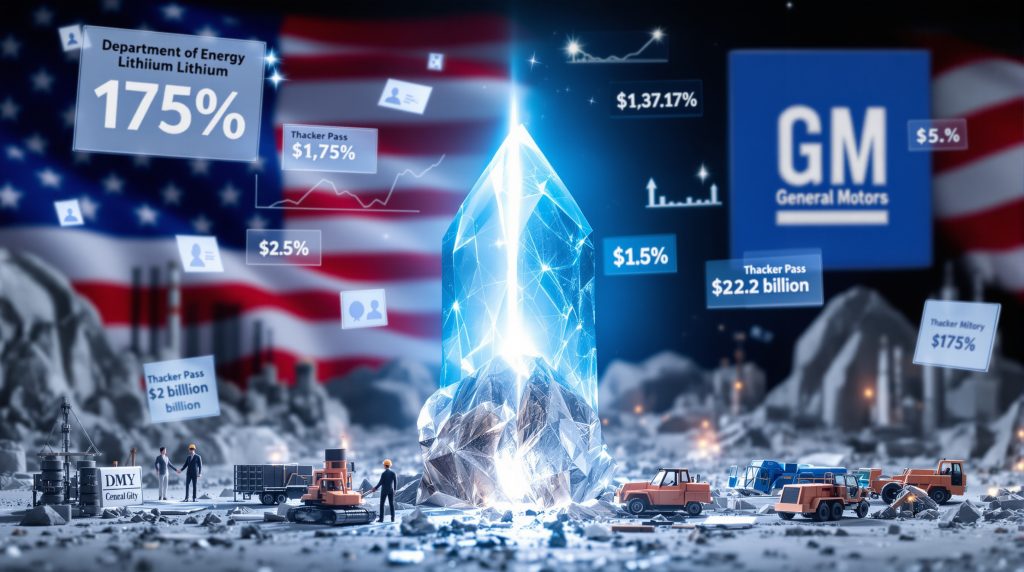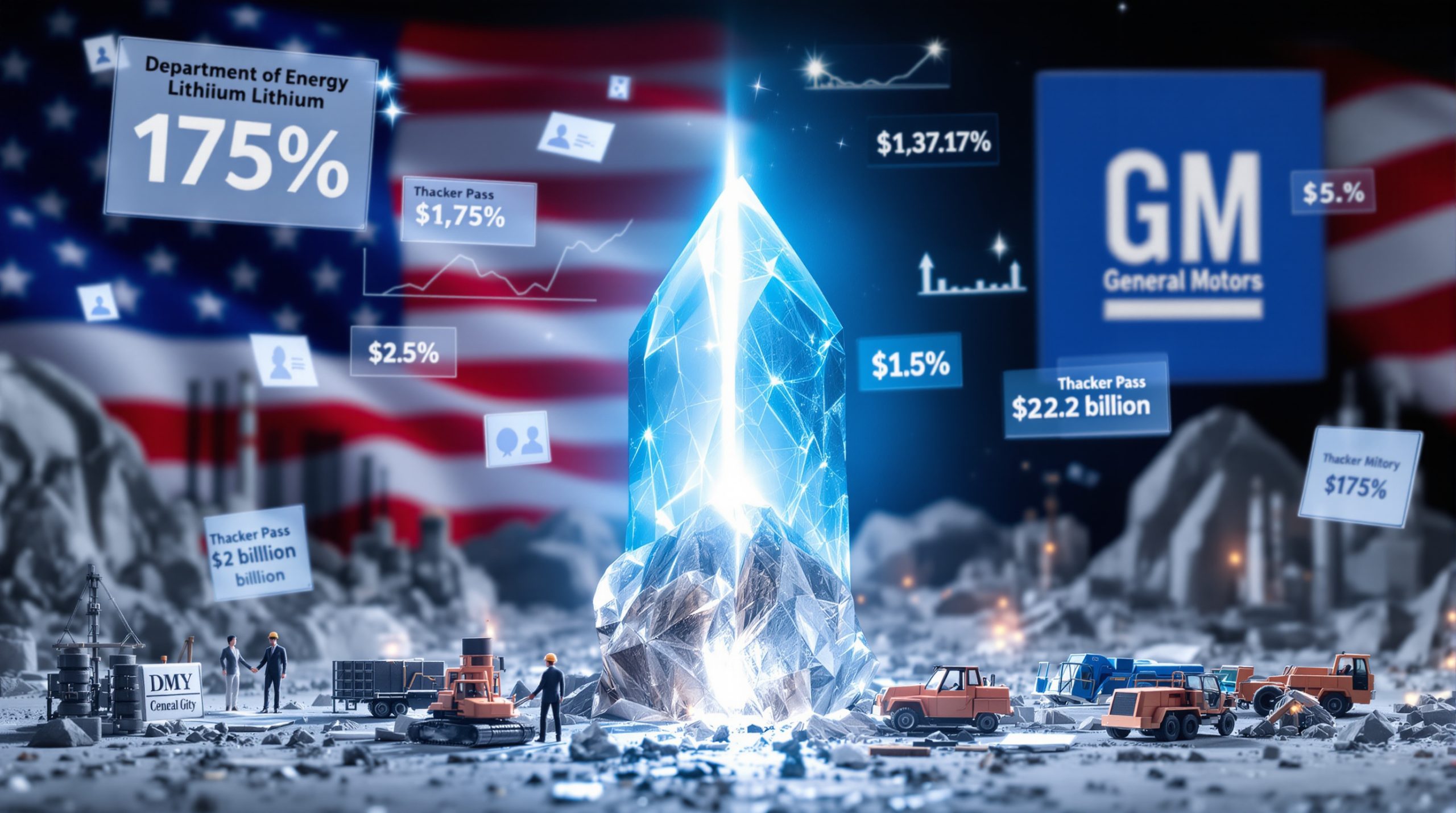Understanding the US Government's Strategic Investment in Lithium Americas
The US government's decision to take an equity position in Lithium Americas represents a significant shift in domestic resource policy. This strategic move aims to secure critical mineral supply chains while reshaping the competitive landscape of North American lithium production.
What Does the US Government's 5% Stake Actually Include?
The government's investment in Lithium Americas comes with a complex structure that extends beyond typical financing arrangements. The 5% equity position actually consists of dual ownership components:
- Dual ownership structure: The US has acquired a 5% equity stake in both Lithium Americas Corporation itself and separately in the Thacker Pass project
- Financial arrangement: The equity stake comes as part of a $435 million initial loan disbursement from a larger $2.23 billion Department of Energy financing package
- Strategic control: Beyond financial investment, the stake gives the government influence in project development decisions and supply chain allocation
This two-tiered approach allows the government to maintain oversight at both the corporate and project levels, securing influence over how lithium resources are developed and allocated.
Why This Government Investment Represents a Policy Shift
The equity acquisition marks a fundamental departure from historical approaches to resource development in the United States:
- Departure from tradition: Direct government ownership in mining companies marks a significant change from historical US resource development approaches
- National security framing: The investment is positioned as essential for reducing dependency on foreign lithium sources, particularly from China
- Precedent-setting arrangement: This deal creates a template for potential future government stakes in other critical mineral producers
This shift toward direct government involvement in critical minerals represents a growing recognition that market forces alone may not secure domestic supply chains in strategically important resources. Furthermore, the recent critical minerals order has intensified focus on securing domestic supply chains for materials deemed essential to national security.
Market Response: The 175% Rally and Subsequent Analyst Concerns
The market's initial reaction to the US government stake was overwhelmingly positive, triggering a dramatic price surge that has since faced scrutiny from financial analysts.
What Drove the Initial 175% Stock Price Surge?
Several key factors contributed to the extraordinary price movement following the announcement:
- Presidential endorsement effect: The deal's association with the administration created significant market excitement
- Supply security premium: Investors placed high value on guaranteed government backing for project completion
- Speculative momentum: The rapid price increase attracted momentum traders, amplifying the initial rally
- Thematic investment appeal: The combination of government support and critical minerals created a compelling narrative for retail investors
The surge represented one of the most dramatic price movements in the mining sector in recent years, highlighting how government involvement can trigger outsized market reactions.
Why Are Analysts Now Downgrading Lithium Americas?
Despite the initial enthusiasm, professional market observers have grown increasingly cautious:
- Valuation concerns: Multiple analysts cite significant overvaluation relative to fundamentals
- Dilution impact: Scotiabank analyst Ben Isaacson specifically highlighted shareholder dilution concerns
- Potential 40% equity dilution: Calculations suggest existing shareholders could face up to 40% dilution if similar concessions accompany future loan tranches
- Profit-taking recommendations: Several analysts have explicitly advised investors to sell and "reload at lower levels"
According to MacMurray Whale, an analyst at Cormark Securities who downgraded Lithium Americas to market perform from buy following the agreement: "If you're an investor and you've seen this triple in a couple months, you take your profits. I would rather tell people to wait to see whether there is a pullback after this excitement."
The Thacker Pass Project: Strategic Significance Beyond Market Movements
While market reactions dominate headlines, the Thacker Pass project itself represents a cornerstone of US mineral independence strategy.
What Makes Thacker Pass Strategically Valuable?
The Nevada-based lithium project offers several unique advantages that explain the government's interest:
- Resource scale: The site contains what many consider the largest known lithium reserve in the United States
- Economic impact: Project development is projected to generate over $1 billion in annual economic activity
- Employment creation: More than 2,400 jobs are expected across construction and operations phases
- Supply chain positioning: The project could significantly reduce US reliance on foreign lithium sources
Beyond raw numbers, the project's location in Nevada provides geological, logistical, and political stability advantages compared to international alternatives. In contrast to the Argentina lithium brine insights that show the challenges of overseas extraction, domestic production offers greater security and control.
How Does the Project Timeline Align With Market Expectations?
The path from investment to production involves several phases that investors must understand:
- Development phases: The project faces several years of construction before reaching full production capacity
- Regulatory hurdles: Despite government backing, environmental and permitting processes continue to influence timelines
- Production targets: Initial production goals must align with both government strategic needs and commercial viability
This multi-year timeline creates a disconnect between current market valuations and actual cash flow generation, contributing to analyst concerns about short-term overvaluation.
Comparing the Government Stake to Other Strategic Investments
The Lithium Americas deal follows a pattern of increasing government intervention in critical mineral development.
How Does This Compare to Other Recent Government Investments?
The Lithium Americas arrangement isn't occurring in isolation:
- MP Materials precedent: The Department of Defense made a $400 million equity investment in rare earth producer MP Materials
- Intel's government backing: Intel received a significant government stake, boosting its shares by over 50%
- Trilogy Metals announcement: The administration recently disclosed another mining sector stake in Trilogy Metals
This wave of investments indicates a systematic approach to securing supply chains across multiple critical resource categories. The recent US mineral production order further demonstrates the government's commitment to securing domestic supply chains.
What's Different About the Lithium Americas Arrangement?
Despite similarities to other strategic investments, the Lithium Americas deal has several unique aspects:
- Dual-level ownership: Unlike other deals, this investment includes stakes in both the parent company and the specific project
- Loan structure complexity: The arrangement combines equity stakes with loan disbursements and debt servicing delays
- Supply chain implications: The deal specifically targets domestic lithium production for battery manufacturing
These distinctions create both opportunities and challenges for investors trying to assess the long-term impact on shareholder value.
General Motors' Role as Major Stakeholder
While government involvement has dominated recent headlines, General Motors remains the largest single stakeholder in Lithium Americas.
How Does GM's 38% Stake Influence the Company's Direction?
The automaker's substantial position creates a powerful voice in corporate governance:
- Substantial investment: GM's $625 million investment secured its position as the dominant corporate stakeholder
- Vertical integration strategy: The stake represents GM's commitment to securing domestic lithium supply for its EV production
- Strategic alignment: GM's interests in project success align with but aren't identical to government objectives
- Decision-making influence: With over one-third ownership, GM maintains significant influence over corporate strategy
This substantial ownership position gives GM considerable influence over development timelines, production allocation, and strategic priorities.
What Are the Potential Conflicts Between Stakeholders?
The presence of multiple strategic stakeholders creates potential governance challenges:
- Production allocation tensions: Government strategic needs may not always align with GM's commercial priorities
- Timeline pressures: Different stakeholders may have divergent preferences regarding development speed versus cost control
- Pricing mechanisms: How lithium is priced between the project and GM could create potential conflicts with other shareholders
Navigating these competing interests will require sophisticated governance structures to balance national security priorities against commercial imperatives.
Institutional Ownership Beyond Government and GM
Despite the prominence of government and GM stakes, institutional investors maintain significant positions in Lithium Americas.
Who Are the Major Institutional Stakeholders?
Professional investment firms continue to play an important role in the company's ownership structure:
- Diversified ownership: Approximately 25% of outstanding shares are held by institutional investors
- ETF inclusion: The company features in various ETFs focused on renewable energy and critical minerals
- Key institutional holders: Major positions are held by firms including Van Eck Associates and UBS Group AG
This institutional presence provides market liquidity while also introducing more financially-focused governance perspectives.
How Might Institutional Perspectives Differ from Strategic Stakeholders?
Institutional investors typically bring different priorities to their ownership positions:
- Return focus: Institutional investors primarily seek financial returns rather than strategic resource control
- Governance concerns: Some institutional investors have expressed concerns about potential conflicts between government and commercial interests
- Liquidity considerations: Market trading dynamics remain influenced by institutional positioning
Seth Goldstein, an analyst at Morningstar Research who downgraded the stock to hold from buy after the share price bypassed their price target, noted: "The market's gone from overly pessimistic on the stock to now overly optimistic, and so we don't see a good price right now for someone looking to buy the stock."
Global Context: US-China Competition for Critical Minerals
The US government's stake in Lithium Americas reflects broader geopolitical competition for control of battery material supply chains.
How Does This Move Counter China's Dominance?
The investment directly addresses growing concerns about China's control over critical mineral supply chains:
- Processing capacity gap: China controls approximately 65% of global lithium processing capacity
- Strategic rebalancing: The US currently produces less than 1% of global lithium, creating significant supply vulnerability
- Vertical integration focus: The investment supports domestic processing capabilities, not just mining operations
This investment represents one piece of a broader strategy to reduce dependency on Chinese-controlled supply chains for energy transition materials. Recent Australia lithium initiatives similarly demonstrate how Western nations are attempting to counter China's dominance in the sector.
What Are the Broader Implications for Global Lithium Markets?
The US government's direct involvement could influence global market dynamics in several ways:
- Price stabilization effects: Government backing may reduce project financing risk premiums
- Supply forecasting impact: Guaranteed project completion affects medium-term global supply projections
- Investment pattern influence: The deal may encourage similar arrangements in other Western jurisdictions
As major economies increasingly view lithium as a strategic resource, government interventions could become a standard feature of project financing.
Future Outlook: What Comes Next for Lithium Americas?
Looking beyond the immediate market reaction, several key factors will determine Lithium Americas' long-term trajectory.
What Key Milestones Will Shape Future Performance?
Investors should monitor several critical developments:
- Construction progress: Adherence to development timelines will significantly impact investor confidence
- Additional financing tranches: How future loan disbursements are structured will affect shareholder value
- Production targets: Meeting initial production goals will be critical for validating the project's viability
- Expansion potential: Plans for scaling beyond initial capacity will influence long-term valuation
The transition from development to production remains the most significant value inflection point in the company's near-term future. Industry experts discussing the lithium americas US equity stake on a recent global lithium podcast highlighted the importance of execution over the next 24 months.
What Are the Potential Regulatory and Political Risks?
Despite government backing, several external factors could influence project execution:
- Policy continuity concerns: Changes in administration could affect government commitment to the project
- Environmental scrutiny: Despite government backing, environmental regulations remain a potential constraint
- Trade policy evolution: Changing tariff structures could impact project economics
According to analysts at JPMorgan Chase & Co., investors can expect more such deals to be hammered in the future. Potential candidates for Energy Department loan revisions include EVgo Inc., one of America's biggest charging companies, and hydrogen producer Plug Power.
FAQ: Key Questions About the US Equity Stake in Lithium Americas
Why did the US government take an equity stake rather than just providing loans?
The equity stake gives the government direct influence over project development and resource allocation decisions, ensuring strategic minerals remain available for domestic use. This approach also provides taxpayers with potential upside if the project succeeds, rather than just loan repayment.
How does this government stake affect other lithium developers?
The precedent suggests other critical mineral developers might receive similar government backing, potentially changing financing dynamics across the sector. Companies with advanced projects in strategic locations may now position themselves for similar arrangements.
What happens if lithium prices fall significantly?
The government stake provides a buffer against market volatility, potentially ensuring project continuation even during price downturns. This stability benefit comes at the cost of dilution for existing shareholders.
Could this arrangement face legal challenges?
While unusual, the government's authority to make such investments is generally established through national security provisions. Some legal experts have suggested potential challenges based on market interference concerns, but these appear unlikely to succeed given the strategic rationale.
Further Exploration
Readers interested in learning more about government investments in critical minerals can explore related educational content, such as Bloomberg's coverage of strategic resource investments and Mining Weekly's reporting on global lithium market developments.
Disclaimer: This article contains market analysis and forward-looking statements regarding Lithium Americas' business prospects. The information presented is for educational purposes only and should not be considered investment advice. Always conduct your own research before making investment decisions, as lithium markets and government policies can change rapidly.
Want to Spot the Next Major Mineral Discovery?
Discovery Alert's proprietary Discovery IQ model instantly notifies investors of significant ASX mineral discoveries, transforming complex data into actionable insights before the broader market catches on. Explore why historic discoveries like De Grey Mining and WA1 Resources delivered exceptional returns by visiting the dedicated discoveries page.




